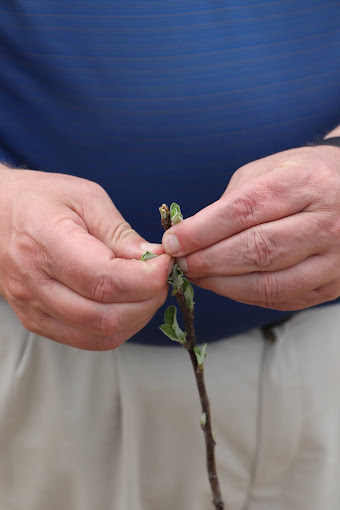In my latest blog post, the beginning of a little series entitled Orchard Days, I wrote that the planting of apple trees seems to consist of merely sticking leafless twigs in the ground at intervals. The end result of this orchard planting is a large field of "whips" poking up in somewhat tidy rows. In an astonishingly short time - a few weeks - these apparently dead whips begin to show signs of life by pushing out bits of green that eventually are recognizable as leaves. Soon after that, one can detect little branches developing on the sides of the whip. This stage of growth in the young apple tree is called "feathering".
When the young saplings begin to feather out, several of the side branches near the top can be pinched off so that more of the plant's vigor will go into the growth of the leader, which is the main branch pushing up from the center of the tree.
The young trees that Martin's Family Fruit Farm plants are not started from seed, but rather from rootstock onto which twigs from selected apple trees have been grafted. The nursery that grafts and provides trees for Martin's to purchase will actually have its workers come out to our orchard to take branches from established apple trees, the particular kind desired in the new orchard, to graft into the stems of rootstock. When the graft takes hold, and the little tree is growing nicely on its own (usually when the tree is 1 or 2 years old), it is ready for planting in its permanent location. In the above photo, the graft union, the place where the scion (piece of branch with a bud) meets the rootstock, is clearly noticeable.
One of the maintenance jobs in a high-density new orchard is trellising. Freshly-planted trees leaning all willy nilly need a support system, as well as structure to position their branches for optimum exposure to sunlight on their fruit in the future.
The main supports in trellising are large wooden poles. These are "planted" at intervals in the tree rows, and are the anchors of the wires and smaller bamboo stakes.
Workers string wire from pole to pole down the apple tree rows. This wiring trailer was custom-built by one of our handyman employees in Vienna.
The smaller bamboo poles also get "planted", one to every tree, attached to the strung wire using wire clips. The trunk and leader branch of each tree is fastened to its own bamboo stake support with flexible rubber ties.
I think the orchard looks so neat and orderly after all the trellising is accomplished. (Weeding and tilling between the rows really helps, too.)
Another maintenance job that is done in a young orchard is putting up wildlife deterrents. That white cube hanging from the orchard wire in the photo is a piece of bar soap. Apparently, deer associate the soap scent with humans and is repelling. Placing soap among the orchard trees keeps the deer from eating the tender young bark and foliage.
Painting the bottom section of the trunks of the apple trees is another pest deterrent.The coat of paint protects the bark from cracking or splitting, thus helping to seal out insects, fungus, and disease that would damage the tree. But more importantly, it acts as a repellent for mice, since a certain chemical is mixed with the paint. The chemical does not harm the rodents, but it literally puts a bad taste in their mouths if the mice encounter it.
Workers use long-handled paintbrushes (made by attaching a regular paintbrush to a stick with tape) to apply white paint to the bottom portion of the young trees.
Eventually, a trickle irrigation system (also called drip irrigation) will be installed in the new orchard. The irrigation tubing, from which the water will drip out, is attached to the trellising close to the base of the trees.
At some point in the orchard maintenance program, labeling of rows will occur. This provides at-a-glance information regarding row number, apple variety, year planted, rootstock type, and orchard identification. I think it is rather unique that this particular apple variety matches its label color.
















My parents have planted over a thousand trees over the last 4 years or so. Excited to see their orchard take shape. Thank you for sharing about yours.
ReplyDeleteYou're welcome! It's exciting to hear about the orchards that others have, too. I wish your parents great success with their new orchard venture.
Delete